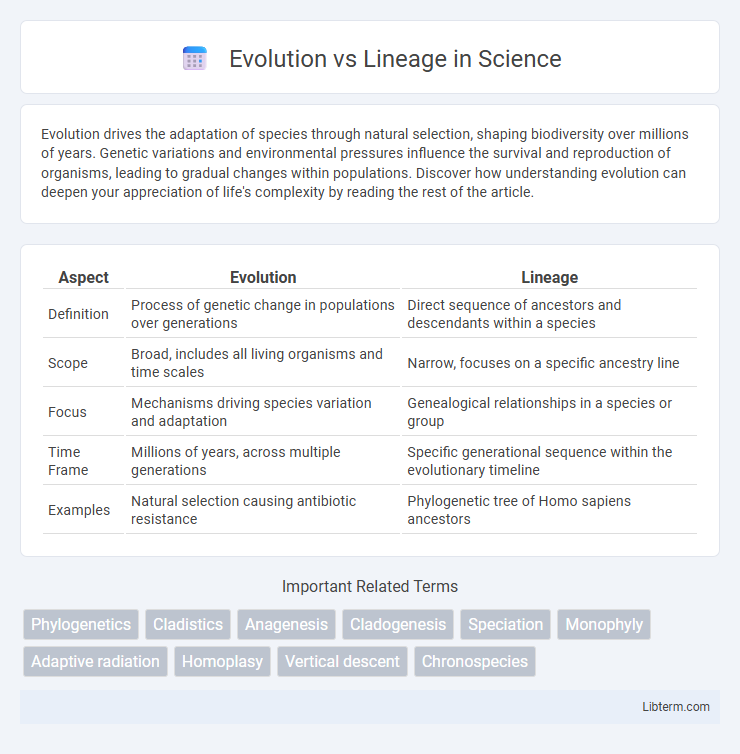Evolution drives the adaptation of species through natural selection, shaping biodiversity over millions of years. Genetic variations and environmental pressures influence the survival and reproduction of organisms, leading to gradual changes within populations. Discover how understanding evolution can deepen your appreciation of life's complexity by reading the rest of the article.
Table of Comparison
| Aspect | Evolution | Lineage |
|---|---|---|
| Definition | Process of genetic change in populations over generations | Direct sequence of ancestors and descendants within a species |
| Scope | Broad, includes all living organisms and time scales | Narrow, focuses on a specific ancestry line |
| Focus | Mechanisms driving species variation and adaptation | Genealogical relationships in a species or group |
| Time Frame | Millions of years, across multiple generations | Specific generational sequence within the evolutionary timeline |
| Examples | Natural selection causing antibiotic resistance | Phylogenetic tree of Homo sapiens ancestors |
Introduction to Evolution and Lineage
Evolution describes the process through which species undergo genetic changes over successive generations, resulting in the development of new traits and increased biodiversity. Lineage refers to the direct sequence of ancestors and descendants, tracing the hereditary path of species or individuals through time. Understanding evolution provides insight into how lineages diverge and adapt, shaping the tree of life.
Defining Evolution: Concepts and Mechanisms
Evolution refers to the process by which species undergo genetic changes over successive generations, driven by mechanisms such as natural selection, mutation, gene flow, and genetic drift. This dynamic process leads to adaptation and diversification within populations, shaping the biodiversity observed in life forms. Understanding evolutionary concepts enables the study of how genetic variation and environmental factors contribute to the emergence of new traits and species over time.
Understanding Lineage: Ancestry and Descent
Understanding lineage involves tracing the direct ancestry and descent of organisms through generations, highlighting genetic connections passed down in a continuous sequence. This concept focuses on the vertical transmission of traits and hereditary information, revealing how species evolve from common ancestors over time. Lineage helps clarify evolutionary relationships by mapping genealogical pathways and distinguishing specific ancestral roots within the broader process of evolution.
Key Differences Between Evolution and Lineage
Evolution refers to the process through which species undergo genetic changes over generations, leading to the development of new traits and sometimes new species, driven by mechanisms like natural selection and genetic drift. Lineage denotes the direct ancestral descent throughout successive generations, tracing the continuity of genetic information within a species or group. The key difference lies in evolution describing how species change over time, while lineage emphasizes the specific ancestral relationships and inheritance paths.
Evolutionary Theories in Modern Biology
Evolutionary theories in modern biology emphasize the gradual genetic changes within populations over generations, driven by natural selection, genetic drift, and gene flow. This process contrasts with lineage, which traces the direct ancestral relationships in phylogenetic trees to map species' common descent. Key models such as the Modern Synthesis integrate Mendelian genetics with Darwinian evolution to explain species adaptation and diversity through evolutionary mechanisms.
Tracing Lineage: Tools and Techniques
Tracing lineage involves using molecular markers such as mitochondrial DNA and single nucleotide polymorphisms (SNPs) to map ancestral relationships within populations. Advanced computational tools like phylogenetic analysis software and bioinformatics algorithms enable researchers to reconstruct lineage trees and identify evolutionary divergence points. Techniques such as radiometric dating and fossil record integration provide temporal context, enhancing the accuracy of lineage tracing in evolutionary studies.
The Role of Genetics in Evolution and Lineage
Genetics plays a fundamental role in evolution by driving heritable changes through mutations, gene flow, and genetic drift, which alter the genetic composition of populations over generations. In lineage, genetics traces the inheritance patterns and relatedness among organisms, revealing evolutionary relationships and divergence points through DNA analysis. Understanding genetic variation enables scientists to map evolutionary pathways and distinguish lineage-specific traits from adaptive changes.
Evolutionary Trees vs. Lineage Charts
Evolutionary trees, also known as phylogenetic trees, illustrate the branching patterns of species diversification based on common ancestors, emphasizing genetic relationships and evolutionary timelines. Lineage charts trace direct ancestral-descendant connections within a single family or species, focusing on linear inheritance and successive generations. Evolutionary trees capture broader biodiversity and speciation events, whereas lineage charts provide detailed genealogical sequences along a specific evolutionary path.
Real-World Examples: Evolution vs. Lineage
Darwin's finches on the Galapagos Islands exemplify evolution through natural selection, where variations in beak shape emerged in response to different food sources over generations. In contrast, lineage is demonstrated by the fossil record of horse species, showcasing a direct ancestral descent with gradual morphological changes. These real-world examples underscore evolution as the mechanism driving diversity, while lineage traces the hereditary relationships among species.
The Significance of Studying Evolution and Lineage
Studying evolution and lineage provides critical insights into the genetic connections and divergence among species, enabling a deeper understanding of biodiversity and adaptation processes. Evolutionary analysis reveals the mechanisms of natural selection and mutation that drive species development over time, while lineage tracing maps ancestry and hereditary traits within populations. This knowledge supports advancements in fields like medicine, conservation biology, and genetics by informing strategies for disease prevention, species preservation, and genetic research.
Evolution Infographic

 libterm.com
libterm.com